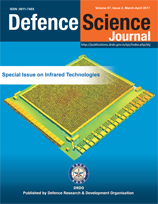Estimation of Effect of Emissivity on Target Detection through Thermal Imaging Systems
DOI:
https://doi.org/10.14429/dsj.67.9821Keywords:
Emissivity, Thermal contrast, Thermal imager, Thermodynamic temperature difference, NVTHERM, Detection rangeAbstract
The effects of target emissivity on apparent thermal contrast as well as on detection range capabilities of thermal imagers in long wave infrared and middle wave infrared bands were evaluated. The apparent thermal contrast (to be seen by the thermal imager at standoff distance), considering only the emission from target and background, was first computed in both the IR bands in terms of target emissivity and secondly the apparent thermal contrast, considering the background radiation reflected off the target, was also computed. A graphical user interface simulation in MATLAB was prepared for the estimation of total apparent thermal contrast taking into account both the emission and reflection. This total apparent thermal contrast was finally used in night vision thermal and image processing model for predicting the detection range performance of thermal imagers. Results of the analysis show that the effect of target emissivity on thermal contrast estimates is more pronounced in LWIR. The lower thermodynamic temperature difference between target and background at lower values of target emissivity leads to negative thermal contrast which in-turn leads to higher detection ranges.
Downloads
Published
How to Cite
Issue
Section
License
 Where otherwise noted, the Articles on this site are licensed under Creative Commons License: CC Attribution-Noncommercial-No Derivative Works 2.5 India
Where otherwise noted, the Articles on this site are licensed under Creative Commons License: CC Attribution-Noncommercial-No Derivative Works 2.5 India


